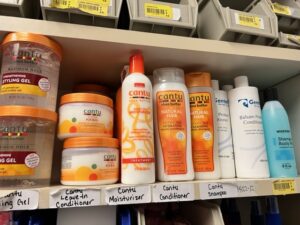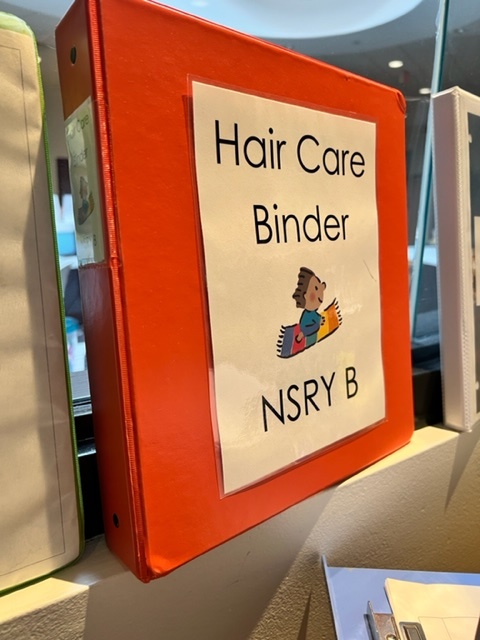In 2020, Ranken Jordan Pediatric Bridge Hospital held Town Hall meetings to listen to team members during a critical time of social unrest across the country.
These meetings sparked a conversation about the need for the team to know how to care for different types of hair. It also highlighted the need to have appropriate hair care products available for patients of all ethnicities.
As a result, the Ranken Jordan’s Diversity, Equity and Inclusion (DEI) Council initiated the Inclusive Hair Care Project to increase staff awareness around how to care for, maintain and style hair of different textures. The overall goal of this project was to ensure all patients are treated fairly regardless of their ethnic background.
The DEI Council’s mission to build a stronger community and foster an inclusive culture of open-mindedness, compassion, understanding, respect and acceptance among individuals and groups.
To support the hair care initiatives hospital-wide, the DEI Council partnered with Ranken Jordan’s clinical education leaders
“Our patients are here with us for a long time,” says Maggie Gregory, clinical nurse educator at Ranken Jordan. “Part of our culture is to get patients out of bed and dressed in street clothes each day. Their hair is part of it. We want to keep patients looking their best so they can feel their best.”
Maggie explains that the nursing staff was responsible for styling patients’ hair but they didn’t always know how to maintain or style it. “They were all doing the best they could but we had gaps in knowing what was best for different types of hair.”
Step 1: Rethinking Hair Care Supplies
 A key part of the hair care initiative was to provide all patients with the products they need to best care for and maintain their hair.
A key part of the hair care initiative was to provide all patients with the products they need to best care for and maintain their hair.
The newly established “Hair Care Team” surveyed staff and researched and trialed various hair care products to determine which items to add to the hospital’s supply room.
“Before the program, we just had basic shampoo, conditioner and hair combs in our supply rooms,” Maggie says. “We didn’t have the supplies stocked the way we needed for all patients.”
Now a wider variety of hair supplies is available so patients don’t have to bring in their own products from home or do without.
“The teenagers were most excited to have the products they needed available,” Maggie says. “They know we now have the right combs and hair moisturizers to get them back to feeling like themselves. Patients also enjoy the one-on-one time with the staff when they are getting their hair styled. They feel pampered.”
Step 2: Involving the Whole Team in Hair Care Education
Maggie and the Hair Care Team created communications and education opportunities for the entire hospital team. Over a month, they conducted weekly “pop-up” in-services at various times and locations around the hospital to reach the most staff. The team demonstrated hair care and styles with patient volunteers as models.
Members of the hospital executive team attended as well as other staff members and patients and families.
“Everyone enjoyed it,” Maggie says. “One teenage boy patient taught us how to do hairstyles himself and he told us what it means to him to have his hair feel and look like it did before his accident. It was also fun to gather on units with patients to take time for one common purpose. The kids were excited to see people together, too.”
The comprehensive staff education included how to maintain the health of different hair textures, how to style hair, what products were appropriate to use in various types of hair, and how often various hair textures need to be washed and brushed.
The Hair Care Team was formed from a cross section of disciplines around the hospital. Currently, nine team members from the kitchen, therapy, nursing, pharmacy and social work make up the Hair Care Team.
“It was fun to see the staff members who spearheaded this project stand up and teach at the in-service about something they are passionate about and are really talented at,” Maggie says.
Increased job satisfaction is one of the side effects of the Inclusive Hair Care Project. “Being part of this is fun for people who typically don’t get to have much hands-on time with patients,” Maggie explains. “Through the hair care team, the non-nursing staff is empowered to take the time they need to be with the kids to do their hair. It’s a way to go back to the Ranken Jordan mission and fill your cup at work outside your normal job duties.”
In addition, an online hair care education module was also created to explain the importance of inclusive hair care and how to care for hair of various textures. The online module is available to all patient care staff and offered as an optional education module to all new patient care employees.
The Hair Care Team ensured information is always easily accessible by creating a binder for each unit with simple instructions on hair care and styling, along with names and photos of hair styles.
This innovative Inclusive Hair Care Project opened the lines of communication among staff members. A Hair Care Team phone group was established so staff could call designated “superusers” to ask questions about hair care so they have immediate access to the resources they need to care for different textures of hair.
“The staff is passionate about it,” Maggie says. “If a staff member is struggling or needs help with hair styling, they can call or email the group anytime and someone will come to help.”
Personalizing Patient Care
The Inclusive Hair Care Project bridged a gap in equality for patients at Ranken Jordan.
The outcome was measured comparing the employee satisfaction survey given in both June 2021 and June 2022. The organization asked two questions related to diversity, equity and inclusion. The satisfaction scores for these questions increased from the previous year after the hair care project was implemented.
“While it wasn’t just our project that increased the scores, seeing the scores go up made us feel like we’re hitting our goal,” Maggie says.
The Inclusive Hair Care Project is important because hair is part of patients’ culture and identity, she adds. “Through the Hair Care Team we are personalizing our patient care. It’s a key goal of Ranken Jordan to make patients feel that they are kids first and in the hospital second.”
The popular project is having a ripple effect throughout the hospital. “It’s empowering our staff to speak up if they notice something missing for our patients,” Maggie says. “Adding products to our supply room is such a simple thing but staff didn’t how to ask for the products. Now the lines of communications are open.”
Projects like these are worth the time and effort, Maggie emphasizes. “Since Ranken Jordan is a small hospital, we can do whatever we need for patients and take the time for it.”
Collaborating to Help Kids Everywhere
Maggie recently gave a poster presentation about the Inclusive Hair Care Project at the Pediatric Complex Care Association (PCCA) annual conference.
“We hope other hospitals can learn from us to help make kids in all hospitals feel and look their best,” she says. “The Inclusive Hair Care Project is a great example of pulling together team members from different departments to tackle big and little issues. Frontline staff members spoke up and were able to work on something outside their normal job duties. The work group offered them a chance to collaborate outside their own department.”
The Inclusive Hair Care Group aligns with Ranken Jordan’s philosophy of getting kids out of bed to play as part of their healing.
“The best thing about Ranken Jordan is that we’re given the opportunity to do extra things for kids outside the normal health care realm,” Maggie says. “The Hair Care Team is another example of how we go the extra mile to make a patient’s day and help them feel their best. It’s all part of our Care Beyond the Bedside model.”

